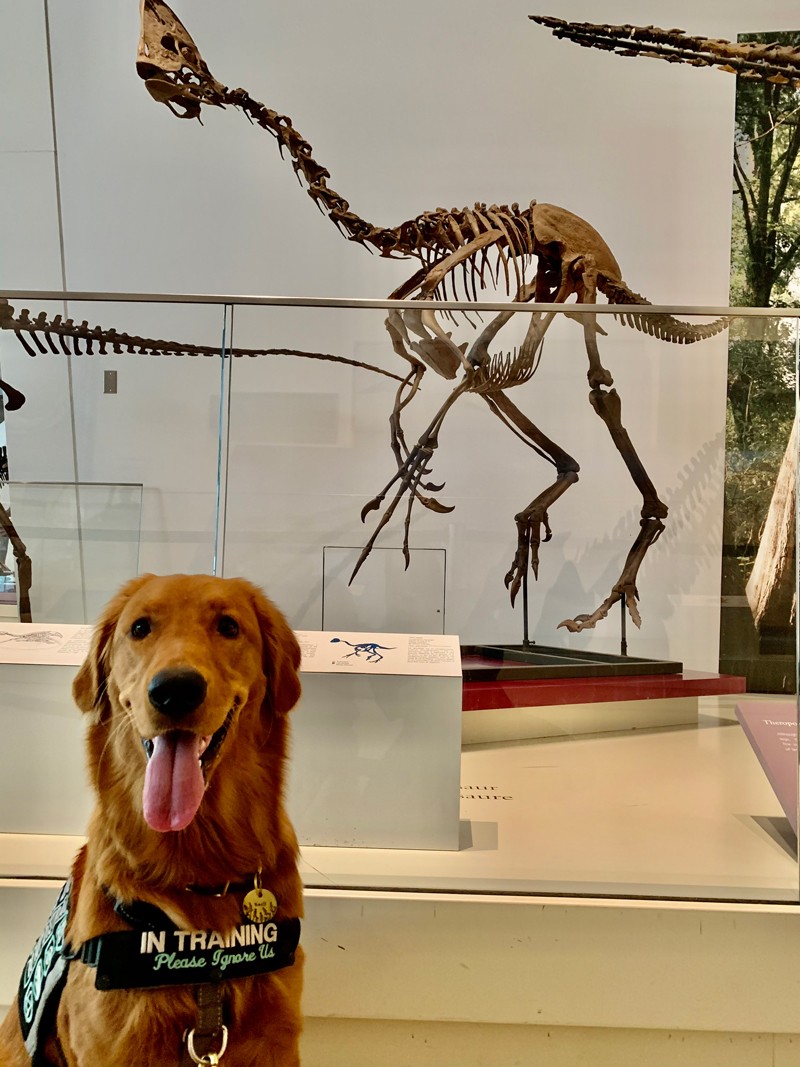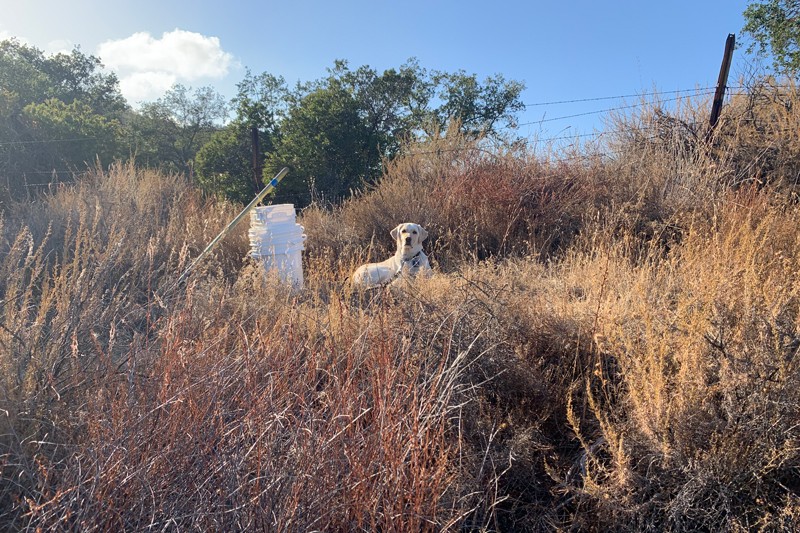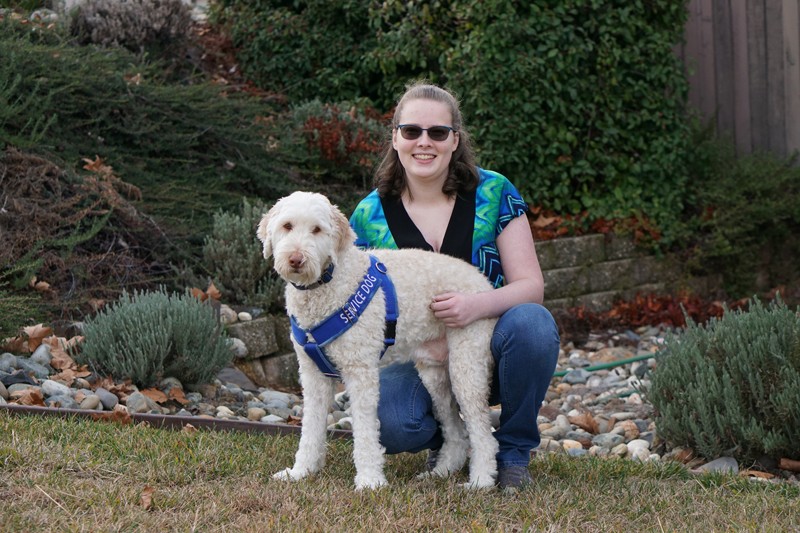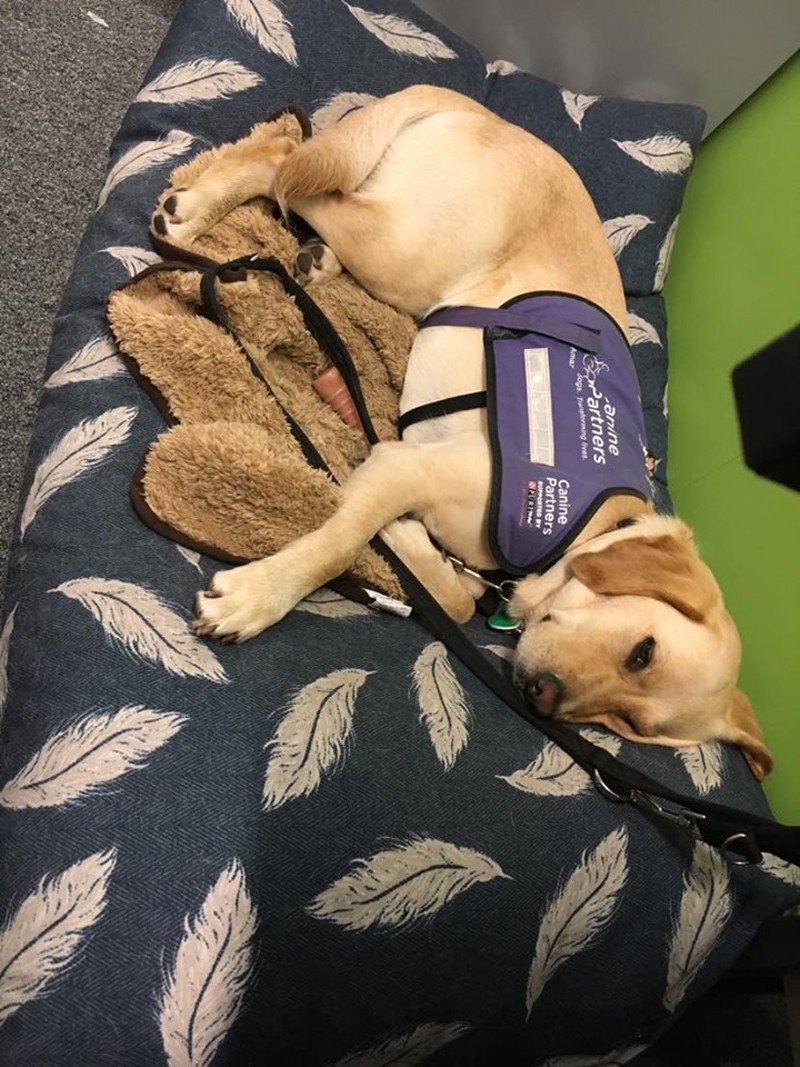When Joey Ramp enrolled in science classes in 2012 at a local community college, she was surprised that she could not bring her assistance dog, Theo, into institutional laboratories. College regulations barred the practice, saying that labs were unsafe environments for support animals. Going it alone wasn’t an option; she needs the help of an assistance dog for tasks such as balancing on stairs and retrieving dropped items. The dog also alerts her to emotional overload.
Ramp had a choice: leave the course or demand access. She chose to stay.
Ramp, whose assistance dog provides support for her physical disability and complex post-traumatic stress disorder, the results of a horse-riding accident in 2006, says that she hadn’t thought to mention Theo in advance of her first classes at the college in Champaign, Illinois. Disability anti-discrimination laws in many nations, including the United States, mandate that assistance dogs have access to most public spaces.
In retrospect, Ramp admits, she was naive to remain silent. Still, she quickly resolved the problem after a two-hour conversation with her lab manager and the college’s director of disability services. She agreed to garb Theo in protective equipment, including goggles and a lab coat, before taking him into the lab.
But Ramp faced more obstacles when she transferred to the University of Illinois Urbana-Champaign, where she earned an undergraduate degree in neuroscience in 2019. She says that it took more than a year of discussions with university administrators and disability-services representatives for her to win the right to bring Theo to particular lab classes. A spokesperson says that the university cannot comment on specific situations and that it has robust accommodations for campus members with disabilities. Eventually, Theo and his successor, Sampson, were able to enter all of Ramp’s lab classes, save one that involved live rodents.
Although she was largely successful in her quest to gain access for her canine supporters, Ramp says that she felt battered by the process, particularly around the need to argue her case again every semester with new professors. “It left me wanting to change the landscape for the people that followed me,” she says.
Today, Ramp is chief executive of Empower Ability Consulting in Champaign, Illinois, which she launched in 2018 to advise universities, other scientific workplaces and people with disabilities on hosting assistance dogs in laboratories. She estimates that her clients number more than 100 individuals and at least a dozen universities.
Increasing numbers
Table of Contents
Assistance or support dogs perform a specific task, or tasks, that mitigate their users’ disability in some way. Categories differ, according to Melissa Winkle, an occupational therapist and assistance-dog trainer at Dogwood Therapy Services in Albuquerque, New Mexico. They include guide dogs that work with people who are blind or visually impaired, dogs that support the deaf or hearing-impaired, mobility-assistance dogs, medical-alert assistance dogs and psychiatric-assistance dogs.
Between 2009 and 2019, the number of support-dog users increased by 42%, according to Assistance Dogs International (ADI), a global coalition of 133 non-profit programmes in North America, Europe, Australia and New Zealand.
The proportion of dogs that help their handlers with disabilities other than vision and hearing has been increasing for at least a decade, says an ADI spokesperson. In 2019, 49% of handlers who were registered with ADI programmes had guide dogs, 7% had hearing dogs and 44% had other types of assistance dog.
Despite rising numbers, many universities remain unprepared for the presence of assistance dogs on campus. Institutional policies often do not mention bringing dogs into lab spaces, for example. “There is this roadblock where it’s often just assumed that it would be too hard,” says Jade Simon, an assistance-dog user who is a palaeobiology PhD student at the Royal Ontario Museum and the University of Toronto in Canada.
Basil, Simon’s current dog, helps her with balance and alerts her to changes in her pulse rate and blood pressure related to a connective-tissue disorder and associated complications. Neither the museum nor the university has robust written guidelines on hosting assistance dogs in the lab. A spokesperson says that the university prefers to address situations individually.
After reading stories about Ramp’s experience, Simon worked with the university on a plan for Charlie, Basil’s predecessor. She can take Basil into the museum’s microscopy lab and is negotiating access to the histology lab where she prepares thin sections from fossil samples.
Simon thinks that institutions need to be better prepared for researchers with assistance dogs who require access to labs. “They need to tackle it like they do any other equity issue and have a comprehensive plan in place ahead of time,” she says.
These guidelines should include considerations of lab-member safety, says Patricia Redden, a chemist at Saint Peter’s University in Jersey City, New Jersey, and a member of the American Chemical Society’s Committee on Chemists with Disabilities. As a volunteer for Canine Companions for Independence in Santa Rosa, California, she fosters future assistance puppies at her home, teaching and socializing each for 18 months in preparation for their transition to a professional trainer. Redden says that support dogs in labs should be positioned so as to not pose a trip hazard — lying down at the back, or in vacant wheelchair spaces — and should not present a hindrance to safe emergency evacuation.
Institutional guidelines should also consider the safety of the dogs, Redden adds. The amount and type of protective equipment needed will vary depending on the type of lab and the person writing the rules.
Ramp says that dogs should wear the same level of protective equipment as their handler. Sampson, for example, wore goggles designed for military and police dogs and one of Ramp’s lab coats under his harness. Redden recommends that support dogs in wet labs wear a bespoke full-coverage chemical-resistant suit. Many handlers agree that dogs should wear booties and lie on a suitable mat in the lab.
Pliable policies
Establishing guidelines around support animals is a positive move towards inclusion, says Sharon Rozovsky, a chemist at the University of Delaware, Newark, who adds that those guidelines must stay flexible. She helps to coordinate a summer research programme for undergraduates with disabilities who want to pursue chemistry or biochemistry. “There can’t be a rigid standard operating procedure,” she says. Every assistance-dog user has different requirements, every dog is different and every lab has a different set of hazards, she adds.
Scientists with support dogs say that universities should involve them in discussions around their dogs’ presence in campus labs. “Researchers can advocate very well for themselves — it won’t be the first time that they have had to explain to people what they need,” says Rozovsky. Debbie Decker, who retired last year from her role as safety manager for the chemistry department at the University of California (UC) Davis, says that she always aimed to collaborate with support-dog users and to prioritize safety for the researcher and their dog.
Discussions should cover whether bringing the dog into the lab is always the best solution, says Redden. Some scientists’ support needs might be better met by another person. Katherine Brafford, a guide-dog user and PhD student in ecology, at UC Davis, leaves her dog, Bing, outside the lab. “A cane, or a sighted guide, just works much better [for me] in a lab setting,” she says. Still, she notes, leaving the dog outside the lab creates other challenges, such as identifying an appropriate location for the dog during lab time. That could be an office space, a crate or a quiet corridor. Brafford leaves Bing in a corridor with a laminated sign asking people to leave him alone. These conversations should begin several months before the researcher will be on campus, says Rozovsky (see ‘Canines at conferences’).
Colleague considerations
Simon says that it is hugely helpful if others on campus do not distract working animals. Those who are around a support dog should not touch, feed or talk to them. “Our dogs are working, and often they are monitoring us for changes in our physiology,” says Simon. Distraction might cause a support dog to miss an alert, which can be life threatening for the scientist, who might have diabetes, cardiac issues or a seizure illness. “It can be downright dangerous [for me] to have people distracting Bing when we’re crossing a street,” says Brafford. She estimates that people try to pet her guide dog at least ten times during an average day on campus.
Isabel Rutten, who studies animal science and management at UC Davis, gets annoyed when people try to sneak photos of her psychiatric and mobility-assistance dog, Winston. “This happened a lot outside my chemistry lab when he was in his boots and lab coat,” she says. “They are taking pictures of my medical equipment.” Brafford says that she feels disappointed when people talk to Bing and not to her, although she concedes that Bing can act as a useful communication tool. “It gives people a good, safe way to talk to me about my disability if they need to,” she says. “They can talk to me about my dog first and then go into other things.”
Lieke van Putten, a postdoc who studies optoelectronics at the University of Southampton, UK, got her mobility-assistance dog, Nell, from the UK charity Canine Partners in Midhurst. The organization e-mailed details about the support animal to van Putten’s colleagues before she and Nell arrived on campus. “In short, it said, ‘Don’t distract the dog’,” van Putten explains, it also asked colleagues to allow her support dog to help her. “Once I got Nell, I didn’t need people to pick up a dropped phone or press a door release button any more,” says van Putten, who uses a wheelchair. “I feel a lot more independent if Nell does that for me.”
Some students and colleagues might be uncomfortable with or afraid of dogs, particularly in certain geographical locations. “There is a widespread fear of dogs in South Africa,” says Juan Erwee, a disability officer at the University of Pretoria, who adds that the use of aggressive police dogs during apartheid, between 1948 and the mid-1990s, might have contributed to the cultural fear. The university runs awareness campaigns, which include information on service animals, to boost understanding of disabilities among students and staff, he says.
Brafford recommends that colleagues who fear a support dog communicate their concerns to its user. When Brafford is aware of such fears, she says, she ensures that Bing keeps his distance from that person.
Although the presence of support dogs on university campuses can still be a challenge for both users and their institutions, researchers who depend on the animals are optimistic that administrators, faculty members and safety officers will eventually smooth the bumps. “My hope,” says Brafford, “is that one day, it won’t be so weird that there are people with disabilities and service animals in science.”





